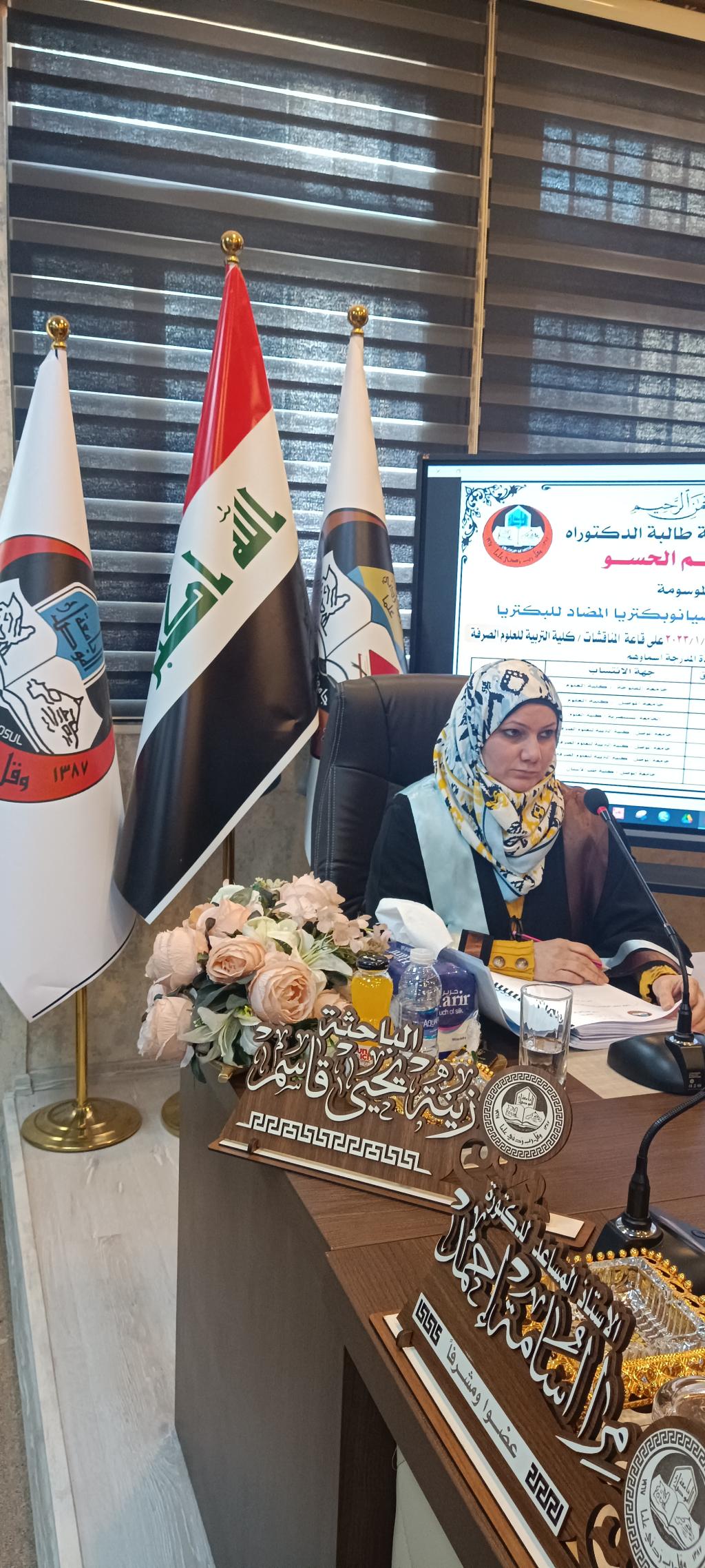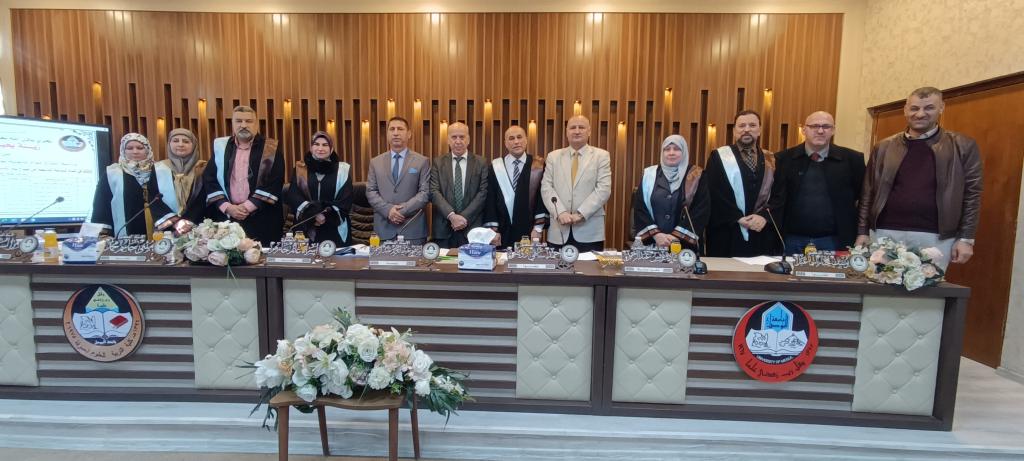26 January، 2023
Ph.D. Dissertation Viva_ Biology Department

PH.D. Dissertation Viva in the College of Education for Pure Science entitled ” Study the production of nanomaterials by antibacterial cyanobacteria “The College of Education for Pure Science, University of Mosul, has done the PH.D. Dissertation Viva entitled ” Study the production of nanomaterials by antibacterial cyanobacteria”,On Thursday, January 26, 2023, the respected Dean of the College, Assistant Professor Dr. Qais Ismail Ibrahim, the Honorable Scientific Associate and Administrative Associate, the Honorable Head of the Department of Biology, and a number of the college’s teachers were attended the viva. In the current study, presented by the PH.D. Student Zena yehea kassim Al- Hasso in the Department of Biology, The biological method for preparing gold and iron nanoparticles using cyanobacterial extracts is one of the modern approved methods for producing nanoparticles that have inhibitory activity against pathogenic bacteria and have antioxidant activity and cancerous tumors. Three genera of cyanobacteria. i.e. (Lyngbya, Gloeocapsa and Fischerella) (phenotypically and moleculary diagnosed by using DNA Sequencing) were selected for the current study. The genera showed matching percentages (100, 90 and 88%) for Lyngbya, Gloeocapsa, and Fischerella, respectively. The genera recorded the best growth density at day 11 in the standard culture medium (Chu10 liquid axis), i.e. (0.571, 0.630, 0.291) for Lyngbya, Gloeocapsa, and Fischerella, respectively.Methanolic and aqueous extracts were conducted for the genera in the current study. Gas chromatography – mass spectrometry GC-MS technology was used to separate and identify the active compounds present in the methanolic extract for each of the three genera. Results indicated the presence of a number of effective compounds, i.e. (35, 39, 40) for (Lyngbya, Gloeocapsa, and Fischerella) respectively. Extracts of the above genera were prepared for aqueous extract by wet weight, dry weight and methanolic extract in order to prepare gold and iron nanoparticles by adding gold chloride and ferric chloride solutions. The properties of the prepared nanoparticles were characterized using Ultraviolet-Visible Spectroscopy (UV-visible), Field Emission Scanning Electron Microscope (FE-SEM) and Fourier Transformation Infrared Spectroscopy (FTIR) and X-ray Diffraction (XRD). The inhibitory effect of bacteria (Escherichia coli, Klebsiella pneumonia, Pseudomonas aeruginosa and Staphylococcus aureus) was studied by using the turbidity measurement. The effectiveness of these antioxidant particles was tested using DPPH method as well as the lethal effect on breast cancer cells (MCF-7). The formation of nanoparticles was first detected by the color change of the solutions and the appearance of purple color for gold nanoparticles and pale yellow and lemon-yellow color for iron nanoparticles. Absorption peaks at different wavelengths where also shown. The highest absorption peak (556) nm was recorded for gold nanoparticles prepared from aqueous extract of dry weight of the genus Fischerella and (316) nm for the iron nanoparticles prepared from the methanolic extract of the genus Gloeocapsa when using the ultraviolet spectroscopy. The shape and size of the formed nanoparticles were determined by field emission scanning electron microscopy (FE-SEM). The particles appeared in a spherical shape with sizes ranging from (13-90) nm for gold particles and (9-98) nm for iron particles. The FTIR infrared spectrum was used also to determine the effective groups that reduce the salt and convert it into nanoparticles. The most important groups were (O-H) bond at absorbance values (3763-3281) cm-1 and the aliphatic (C-H) bond group at absorbance values (2900-2700) cm-1. The carbonyl bonds (C=O) at absorbance values (1679-1649) and the (N=O) bonds, and (C-O) at absorbance values (1404-1115-1052) cm-1 respectively. The X-ray diffraction test detect the presence of different peaks of gold and iron nanoparticles. It was also found that averages of crystal size of the gold nanoparticles prepared from the extracts of the genus Lyngbya were (12, 24, 32) nm for all the aqueous extract in wet, dry and methanolic weights respectively and the average size of the crystalline of gold nanoparticles prepared from wet, dry and methanolic extracts of the genus Fischerella reached (62, 13 and 14) nm respectively, while the averages of crystal size of gold nanoparticles prepared from wet, dry weight extracts and methanolic extract of the genus Gloeocapsa were (12, 7.7, 10) nm respectively. The X-ray diffraction examination of iron nanoparticles prepared from cyanobacteria showed that the average crystal sizes were (19, 16.5, and 18) nm for the particles prepared from wet, dry and methanolic extract of the genus Lyngbya respectively and the averages of crystal size were (34.7, 19, 20) nm for each of the nanoparticles prepared from the wet, dry and methanolic extracts respectively. for the genus Fischerella. In addition, the nanoparticles prepared from the aqueous extracts of the wet, dry and methanolic extracts of the genus Gloeocapsa had an average crystal size of ( 18, 17 and 40 ) nm respectively .The antibacterial activity of gold and iron nanoparticles was studied against Gram-positive and Gram-negative pathogenic bacteria by using turbidity method. The highest inhibition rate was 100% against Staphylococcus aureus and Pseudomonas aeruginosa when using gold nanoparticles prepared from the aqueous extract with dry weight and the methanolic extract of the genus Lyngbya, as well as the aqueous extract by dry weight of the genus Fischerella, while the iron nanoparticles had the best results against Escherisia coli and Staphylococcus aureus bacteria and reached 100% when using the nanoparticles prepared from the methanolic extract of the genus Gloeocapsa .Results of the antioxidant activity using (DPPH) methods (Diphenyl-2-picryl Hydrzyl-2,2) showed that the methanolic extract of both Lyngbya and Gloeocapsa gave the highest antioxidant activity (64.20%) and (59.03%) at concentration of (200 mg/ml) respectively, while the anti-tumor activity of the gold nanoparticles prepared from the methanolic extract of the genus (Lyngbya) against breast cancer cells (MCF-7) in humans was (57.18%) at concentration of (200 mg/ml). Results for the current study showed good efficacy of nanoparticles prepared from the three cyanobacteria extracts by adding gold chloride and ferric chloride as antibacterial materials for pathogenic gram-positive and negative bacteria as well as antioxidants and killers of cancer cells.The Viva committee was chaired by Prof. Dr. Ibrahim A.Al – Rahman / University of Fallujah / College of Science and the membership of Prof. Dr Essra Ghanem Hazem AL- Sammak / University of Mosul / College of Science, Prof. Dr. Ahmed Sahi Dwaish / University of Mustansiriyah / College of Science, Prof. Dr. Muthana Jasim Al- Taee / University of Mosul / College of Education for Pure Science, Prof. Dr. Yousif Jabar AL-Shaheree / University of Mosul / College of Education for Pure Science and under the supervision and membership of both Asst Prof. Dr. Mira Ausama Ahmed Al-Katib / University of Mosul / College of Education for Pure Science and Asst Prof. Dr. Ghada Younis Abdulrahman / University of Mosul / College of Dentistry.















